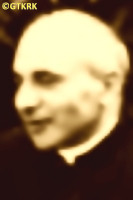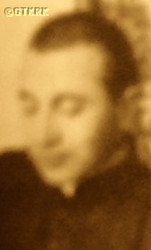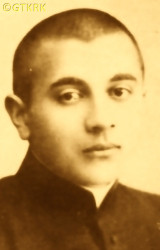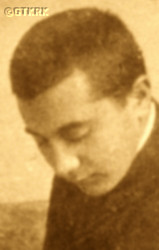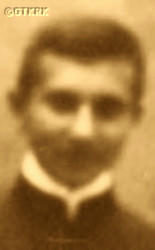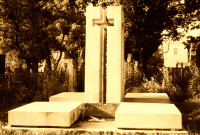Roman Catholic
St Sigismund parish
05-507 Słomczyn
85 Wiślana Str.
Konstancin deanery
Warsaw archdiocese, Poland
full list:
displayClick to display full list

searchClick to search full list by categories
wyświetlKliknij by wyświetlić pełną listę po polsku

szukajKliknij by przeszukać listę wg kategorii po polsku

Martyrology of the clergy — Poland
XX century (1914 – 1989)
personal data
surname
BOGDANOWICZ-ROSZKO
surname
versions/aliases
BOGDANOWICZ de ROSCO
forename(s)
Adam Henry (pl. Adam Henryk)
function
diocesan priest
creed
Armenian Catholic Church ACmore on
en.wikipedia.org
[access: 2013.05.19]
diocese / province
Lviv AC archeparchymore on
en.wikipedia.org
[access: 2017.01.21]
OR Military Ordinariate of Polandmore on
pl.wikipedia.org
[access: 2024.12.13]
honorary titles
Minor Canonmore on
en.wikipedia.org
[access: 2014.11.14]
(1933 – , Assumption of the Blessed Virgin Mary AC cathedral church, Lvivtoday: Lviv urban hrom., Lviv rai., Lviv obl., Ukraine
more on
en.wikipedia.org
[access: 2022.01.16])
„Medal of Independence”more on
en.wikipedia.org
[access: 2019.02.02]
(03.06.1933)
date and place
of death
24.02.1941

Lvivtoday: Lviv urban hrom., Lviv rai., Lviv obl., Ukraine
more on
en.wikipedia.org
[access: 2022.01.16]
alt. dates and places
of death
29.11.1940, 24.06.1941, 25.06.1941
details of death
After outbreak of the World War I as a 17 years old youth joined 2.
Polish Legionaire Brigade.
Wounded during a skirmish at Czerniowce in Bukovina region and released from the army.
After German and Russian invasion of Poland in 09.1939 and start of the World War II collaborated under nom–de–guerre „Dog” with an emerging Polish clandestine resistance Armed Struggle Union ZWZ organization (part of later Polish Clandestine State), as a member of its Treasury Commission.
Arrested by the Russians during the night of 01/02.04.1940 as part of mass arrests of ZWZ members.
Jailed in Zamarstynów prison in Lviv (and/or Brygidki prison).
Repeatedly interrogated (on 11.04.1940 thrice for 19 hours).
Tortured.
Had his testes repeatedly crushed and beaten.
During the night of 19/20.11.1940 tried in a process of 14 ZWZ leaders and at 02:00 in the morning sentenced by Russians to death.
Prob. on 23.02.1941 moved to Łąckiego Str. prison in Lviv.
There murdered in a mass execution of 13 ZWZ leaders from Lviv district.
Among them was Fr John Kisiel as well.
alt. details of death
According to some sources was not executed with ZWZ leaders. Kept in Brygidki prison in Lviv. Also possibly temporarily in Łubianka prison in Moscow.
During a panic escape of Russians from Lviv resulting from German attack on 20.06.1931 and their rapid advance, refused to leave the prison when students freed part of it and stayed inside helping to open the other inmates' cells.
Murdered when Russians temporarily returned and slaughtered the prisoners.
cause of death
mass murder
perpetrators
Russians
sites and events
Lviv (Brygidki)Click to display the description, 06.1941 massacres (NKVD)Click to display the description, Moscow (Lubyanka)Click to display the description, Lviv (Łąckiego)Click to display the description, Trial of 19‐20.11.1940Click to display the description, Lviv (Zamarstiniv)Click to display the description, Ribbentrop‐MolotovClick to display the description, Pius XI's encyclicalsClick to display the description
date and place
of birth
12.07.1898

Dolynyanytoday: Horodok urban hrom., Lviv rai., Lviv obl., Ukraine
more on
uk.wikipedia.org
[access: 2022.08.05]
parents
BOGDANOWICZ Stanislav
🞲 ?, ? — 🕆 ?, ?

BOHDANOWICZ Justine
🞲 ?, ? — 🕆 ?, ?
presbyter (holy orders)
ordination
1920

Krakówtoday: Kraków city pov., Lesser Poland voiv., Poland
more on
en.wikipedia.org
[access: 2021.06.07]
RC chapelmore on
en.wikipedia.org
[access: 2022.12.21] (at the Bishop's Palace at 3_Franciszkańska Str.)
positions held
1933 – 1940
Minor Canon — Lvivtoday: Lviv urban hrom., Lviv rai., Lviv obl., Ukraine
more on
en.wikipedia.org
[access: 2022.01.16] ⋄ Assumption of the Blessed Virgin Mary AC archcathedral church ⋄ Lviv AC archdiocese — also: pro‐synodal examiner, censor of religious books, retreat leader, 1935‐1938 chief editor of the archdiocesan „Gregoriana” magazine
c. 1933 – 1940
promoter of justice and defender of the marriage bond — Lvivtoday: Lviv urban hrom., Lviv rai., Lviv obl., Ukraine
more on
en.wikipedia.org
[access: 2022.01.16] ⋄ Archbishop's Archdiocesan Court ⋄ Lviv AC archdiocese
1927 – 1935
parish priest — Horodenkatoday: Horodenka urban hrom., Kolomyia rai., Stanislaviv/Ivano‐Frankivsk obl., Ukraine
more on
en.wikipedia.org
[access: 2020.11.22] ⋄ Immaculate Conception of the Blessed Virgin Mary AC parish ⋄ Kutytoday: Kuty hrom., Kosiv rai., Stanislaviv/Ivano‐Frankivsk obl., Ukraine
more on
en.wikipedia.org
[access: 2022.07.05] AC deanery
c. 1926 – 1927
treasurer (Lat. thesaurarius) — Lvivtoday: Lviv urban hrom., Lviv rai., Lviv obl., Ukraine
more on
en.wikipedia.org
[access: 2022.01.16] ⋄ Archdiocesan Curia ⋄ Lviv AC archdiocese
1924 – 1927
vicar — Lvivtoday: Lviv urban hrom., Lviv rai., Lviv obl., Ukraine
more on
en.wikipedia.org
[access: 2022.01.16] ⋄ Assumption of the Blessed Virgin Mary AC archcathedral parish ⋄ Lvivtoday: Lviv urban hrom., Lviv rai., Lviv obl., Ukraine
more on
en.wikipedia.org
[access: 2022.01.16] AC deanery — also: c. 1925‐1927 head of the cathedral sacristy, c. 1926 prefect at the Private Institute for Economic Education of Women in the Snopkiv estate in Lviv
1923 – 1924
chaplain — Walmertoday: Kent Cou., England, United Kingdom
more on
en.wikipedia.org
[access: 2022.07.21] ⋄ Roselands monastery, Visitandines VSM
1923
vicar — Lvivtoday: Lviv urban hrom., Lviv rai., Lviv obl., Ukraine
more on
en.wikipedia.org
[access: 2022.01.16] ⋄ Assumption of the Blessed Virgin Mary AC archcathedral parish ⋄ Lvivtoday: Lviv urban hrom., Lviv rai., Lviv obl., Ukraine
more on
en.wikipedia.org
[access: 2022.01.16] AC deanery — also: chaplain and secretary to the Armenian Ordinary of Lviv, Archbishop Joseph Teodorowicz
1921 – 1923
PhD student — Warsawtoday: Warsaw city pov., Masovia voiv., Poland
more on
en.wikipedia.org
[access: 2021.10.09] ⋄ philosophy, University of Warsaw [i.e. University of Warsaw (from 1945) / clandestine University (1939‐1945) / Joseph Piłsudski University (1935‐1939) / University of Warsaw (1915‐1935) / Imperial University of Warsaw (1870‐1915)] — PhD thesis prob. Lat. „De Donis Spiritus Sancti Vitam contemplativam informantibus Secundum Doctrinam Doctoris Thomae” (Eng. „On the Gifts of the Holy Spirit Forming the Contemplative Life According to the Teaching of Doctor Thomas”), unfinished due to excess commitments in pastoral work
1921 – 1923
librarian — Warsawtoday: Warsaw city pov., Masovia voiv., Poland
more on
en.wikipedia.org
[access: 2021.10.09] ⋄ Library of Religious Knowledge — also: co‐founder
1916 – 03.07.1920
student — Lvivtoday: Lviv urban hrom., Lviv rai., Lviv obl., Ukraine
more on
en.wikipedia.org
[access: 2022.01.16] ⋄ philosophy and theology, Department of Theology, John Casimir University [i.e. clandestine John Casimir University (1941‐1944) / Ivan Franko University (1940‐1941) / John Casimir University (1919‐1939) / Franciscan University (1817‐1918)]
others related
in death
KANIAKClick to display biography Michael Augustus (Fr Ceslav), KISIELClick to display biography John, PANAŚClick to display biography Joseph, AGOPSOWICZClick to display biography Bogdan, KAJETANOWICZClick to display biography Dennis (Fr Roman), PRYLIŃSKIClick to display biography Lester (Fr Casimir), RZEPKO–ŁASKIClick to display biography Stanislav
sites and events
descriptions
Lviv (Brygidki): Penal prison, then at 34 Kazimierzowska Str. in Lviv — in the buildings of the former monastery of the Order of St Brigid, in 1784 — after the first partition of Poland and after the dissolution of the religious orders as part of the so—called Josephine dissolutions — converted by the partitioning Austrian authorities into a prison. In 1939‐1941, the Russians held there thousands of prisoners, most of them Poles. On c. 26.06.1941, in the face of the German invasion and attack of their erstwhile ally, the Russians, during a panic escape (the left Lviv exactly on 26.06.1941), genocideally murdered several thousand prisoners. In 1941‐1944 the prison was run by the Germans and mass murders of Polish, Jewish and Ukrainian civilians took place there. After start of another Russian occupation in 1941 prison in which the executions were carried out on prisoners sentenced to death. (more on: en.wikipedia.orgClick to attempt to display webpage
[access: 2014.09.21])
06.1941 massacres (NKVD): After German attack of Russian‐occupied Polish territory and following that of Russia itself, before a panic escape, Russians murdered — in accordance with the genocidal order issued on 24.06.1941 by the Russian interior minister Lawrence Beria to murder all prisoners (formally „sentenced” for „counter‐revolutionary activities”, „anti‐Russian acts”, sabotage and diversion, and political prisoners „in custody”), held in NKVD‐run prisons in Russian occupied Poland, Lithuania, Latvia and Estonia — c. 40,000‐50,000 prisoners. In addition Russians murdered many thousands of victims arrested after German attack regarding them as „enemies of people” — those victims were not even entered into prisons’ registers. Most of them were murdered in massacres in the prisons themselves, the others during so‐called „death marches” when the prisoners were driven out east. After Russians departure and start of German occupation a number of spontaneous pogroms of Jews took place. Many Jews collaborated with Russians and were regarded as co‐responsible for prison massacres. (more on: en.wikipedia.orgClick to attempt to display webpage
[access: 2021.12.19])
Moscow (Lubyanka): Location of a murderous Russian Cheka and next GPU and NKVD (later MVD and KGB) organisations and a prison (in the basement, with 118 cells — in 1936 — of which 94 were solitary — altogether at any time up to 350 prisoners were held there and c. 2,857 in 1937) in Moscow at Lubyanka Square where Russians interrogated and murdered many political prisoners. Most of the prisoners after investigations were transferred to other Moscov prisons, e.g. Butyrki. (more on: en.wikipedia.orgClick to attempt to display webpage
[access: 2014.10.31])
Lviv (Łąckiego): Prison at Łącki Str. in Lviv. Founded in 1918‐1920 by Polish authorities, mainly for political prisoners. From 1935 used as investigative jail. After German and Russian invasion of Poland in 09.1939 and start of the World War II, after start of Russian occupation Russians — local branch of Russian genocidal NKVD organisation — held thousands of prisoners, mainly Poles and Ukrainians, in prison (then prison no 1). It was also a place of carrying out death sentences passed by Russian summary courts on Poles suspected of participation in Polish clandestine resistance activities. In 06.1941, after German attack on 22.06.1941 of their erstwhile ally, Russians, NKVD agents slaugher — during genocidal massacres of prisoners — c. 924 inmates. During German occupation that followed in 1941‐1944 the prison’s buildings held German Gestapo investigative jail. It was a place of executions. In 1944‐1991, after German defeat and start of another Russian occupation, the building were again used by NKVD (and it successor MVD) as investigative jail and also investigative department. (more on: pl.wikipedia.orgClick to attempt to display webpage
[access: 2014.10.31])
Trial of 19‐20.11.1940: In 03.1940 till 06.1940 Russians arrested in Lviv hundreds of members of an emerging Polish clandestine resistance Armed Struggle Union ZWZ organization (part of later Polish Clandestine State). They were held in Lviv prisons. Tortured (special fame earned Russian genocidal NKVD sadistic member, J. M. Libenson of Jewish origin). 14 of them were tried in Zamarstynów prison during the night of 19‐20.11.1940, before a «NKVD Troika» — a murderous Russian court. Prosecuted Mr Nowicki, Ukrainian. All stated that they were proud members of ZWZ. At 02:00 in the morning 13 of them were sentenced to death, among them two priests. One, as a juvenile, got 10 years in Russian concentration camps Gulag (and perished there, prob. in Kołyma). On 11.12.1940 Russian Kiev prosecutors’ office „did not endorse cassation applications” (one of the condemned, Fr Bogdanowicz, wrote his in Polish!). On 21.12.1940 the Criminal College at Supreme Court in Kiev upheld most of the sentences. Finally on 17.02.1941 all sentences were upheld by Russian Supreme Court in Moscow. All condemned in this „trial of the fourteen” were thus executed by the Russians, prob. Katyń style, with a shot to the back of the head. (more on: www.google.plClick to attempt to display webpage
[access: 2017.01.21])
Lviv (Zamarstiniv): Penal prison no 2 in Lviv. In 1939‐1941 Russians organised there an NKVD detention centre and jailed thousands of prisoners, mainly Poles and Ukrainians, interrogating them and torturing. In 06.1941 after German invasion Russians murdered few thousands of them in a mass massacre. (more on: pl.wikipedia.orgClick to attempt to display webpage
[access: 2015.09.30])
Ribbentrop‐Molotov: Genocidal Russian‐German alliance pact between Russian leader Joseph Stalin and German leader Adolf Hitler signed on 23.08.1939 in Moscow by respective foreign ministers, Mr. Vyacheslav Molotov for Russia and Joachim von Ribbentrop for Germany. The pact sanctioned and was the direct cause of joint Russian and German invasion of Poland and the outbreak of the World War II in 09.1939. In a political sense, the pact was an attempt to restore the status quo ante before 1914, with one exception, namely the „commercial” exchange of the so‐called „Kingdom of Poland”, which in 1914 was part of the Russian Empire, fore Eastern Galicia (today's western Ukraine), in 1914 belonging to the Austro‐Hungarian Empire. Galicia, including Lviv, was to be taken over by the Russians, the „Kingdom of Poland” — under the name of the General Governorate — Germany. The resultant „war was one of the greatest calamities and dramas of humanity in history, for two atheistic and anti‐Christian ideologies — national and international socialism — rejected God and His fifth Decalogue commandment: Thou shall not kill!” (Abp Stanislav Gądecki, 01.09.2019). The decisions taken — backed up by the betrayal of the formal allies of Poland, France and Germany, which on 12.09.1939, at a joint conference in Abbeville, decided not to provide aid to attacked Poland and not to take military action against Germany (a clear breach of treaty obligations with Poland) — were on 28.09.1939 slightly altered and made more precise when a treaty on „German‐Russian boundaries and friendship” was agreed by the same murderous signatories. One of its findings was establishment of spheres of influence in Central and Eastern Europe and in consequence IV partition of Poland. In one of its secret annexes agreed, that: „the Signatories will not tolerate on its respective territories any Polish propaganda that affects the territory of the other Side. On their respective territories they will suppress all such propaganda and inform each other of the measures taken to accomplish it”. The agreements resulted in a series of meeting between two genocidal organization representing both sides — German Gestapo and Russian NKVD when coordination of efforts to exterminate Polish intelligentsia and Polish leading classes (in Germany called «Intelligenzaktion», in Russia took the form of Katyń massacres) where discussed. Resulted in deaths of hundreds of thousands of Polish intelligentsia, including thousands of priests presented here, and tens of millions of ordinary people,. The results of this Russian‐German pact lasted till 1989 and are still in evidence even today. (more on: en.wikipedia.orgClick to attempt to display webpage
[access: 2015.09.30])
Pius XI's encyclicals: Facing the creation of two totalitarian systems in Europe, which seemed to compete with each other, though there were more similarities than contradictions between them, Pope Pius XI issued in 03.1937 (within 5 days) two encyclicals. In the „Mit brennender Sorge” (Eng. „With Burning Concern”) published on 14.03.1938, condemned the national socialism prevailing in Germany. The Pope wrote: „Whoever, following the old Germanic‐pre‐Christian beliefs, puts various impersonal fate in the place of a personal God, denies the wisdom of God and Providence […], whoever exalts earthly values: race or nation, or state, or state system, representatives of state power or other fundamental values of human society, […] and makes them the highest standard of all values, including religious ones, and idolizes them, this one […] is far from true faith in God and from a worldview corresponding to such faith”. On 19.03.1937, published „Divini Redemptoris” (Eng. „Divine Redeemer”), in which criticized Russian communism, dialectical materialism and the class struggle theory. The Pope wrote: „Communism deprives man of freedom, and therefore the spiritual basis of all life norms. It deprives the human person of all his dignity and any moral support with which he could resist the onslaught of blind passions […] This is the new gospel that Bolshevik and godless communism preaches as a message of salvation and redemption of humanity”… Pius XI demanded that the established human law be subjected to the natural law of God , recommended the implementation of the ideal of a Christian state and society, and called on Catholics to resist. Two years later, National Socialist Germany and Communist Russia came together and started World War II. (more on: www.vatican.vaClick to attempt to display webpage
[access: 2023.05.28], www.vatican.vaClick to attempt to display webpage
[access: 2023.05.28])
sources
personal:
www.wiki.ormianie.plClick to attempt to display webpage
[access: 2013.01.26], www.katolicy.euClick to attempt to display webpage
[access: 2021.12.19], www.polska1918-89.plClick to attempt to display webpage
[access: 2017.01.21], katolicy1844.republika.plClick to attempt to display webpage
[access: 2021.12.19], cejsh.icm.edu.plClick to attempt to display webpage
[access: 2024.03.22]
bibliographical:
„Trial of the Fourteen”, Ms Elisabeth Kotarska, Volumen, 1998
original images:
cejsh.icm.edu.plClick to attempt to display webpage
[access: 2024.03.22], www.wiki.ormianie.plClick to attempt to display webpage
[access: 2013.01.26], www.wiki.ormianie.plClick to attempt to display webpage
[access: 2017.01.21], www.wiki.ormianie.plClick to attempt to display webpage
[access: 2021.12.19], www.wiki.ormianie.plClick to attempt to display webpage
[access: 2017.01.21], www.wiki.ormianie.plClick to attempt to display webpage
[access: 2017.01.21], www.wiki.ormianie.plClick to attempt to display webpage
[access: 2017.01.21], www.wiki.ormianie.plClick to attempt to display webpage
[access: 2014.05.09], ipn.gov.plClick to attempt to display webpage
[access: 2019.02.02]
LETTER to CUSTODIAN/ADMINISTRATOR
If you have an Email client on your communicator/computer — such as Mozilla Thunderbird, Windows Mail or Microsoft Outlook, described at WikipediaPatrz:
en.wikipedia.org, among others — try the link below, please:
LETTER to CUSTODIAN/ADMINISTRATORClick and try to call your own Email client
If however you do not run such a client or the above link is not active please send an email to the Custodian/Administrator using your account — in your customary email/correspondence engine — at the following address:

giving the following as the subject:
MARTYROLOGY: BOGDANOWICZ-ROSZKO Adam Henry
To return to the biography press below:
 Click to return to biography
Click to return to biography








